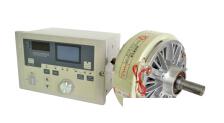● The excitation current is linearly related to the torquelinear relationship
Magnetic powder clutches and magnetic powder brakes operate based on electromagnetic principles using magnetic powder to transmit torque, and the transmitted torque is essentially linearly related to the excitation current. Therefore, by simply changing the magnitude of the excitation current, the torque can be easily controlled. Under normal circumstances, within 5% to the rated torque range, the excitation current is directly proportional to the transmitted torque.
When the excitation current remains constant, the transmitted torque is not affected by the slip (slip speed) between the driving and driven components, meaning there is no difference between static torque and dynamic torque. Therefore, it can stably transmit a constant torque. If this characteristic is applied to tension control, users only need to adjust the magnitude of the excitation current to accurately control and transmit the required torque, thus achieving the goal of controlling the tension of the rolled material conveniently and effectively.
● Application range of magnetic powder clutches
Due to the above characteristics, magnetic powder clutches and brakes have been widely used in the paper-making, printing, plastic, rubber, textile, dyeing, wire and cable, metallurgy, and other related industries for unwinding and rewinding tension control. In addition, magnetic powder clutches can also be used for buffering startup, overload protection, and speed regulation. Magnetic powder brakes are also frequently used for loading and braking in transmission machinery.
● The selection of magnetic powder clutches is generally based on the required transmittedlarge torque and attention must also be paid to ensure that the actual slip power is less than the allowable slip power of the magnetic powder clutch.













